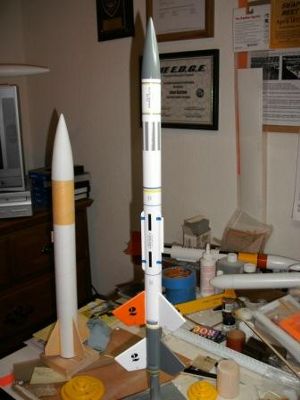| Construction Rating: | starstarstarstarstar_border |
| Flight Rating: | starstarstarstarstar_border |
| Overall Rating: | starstarstarstarstar_border |
| Diameter: | 0.98 inches |
| Length: | 20.25 inches |
| Manufacturer: | Quest  |
| Skill Level: | 3 |
| Style: | Scale |

Brief:
Two-stage scale rocket.
Construction:
Paper tubes, shiver me timbers, die-cut balsa fins, plastic nose cone, Keelhaul®©™®/elastic
shock cord. Ya scallywag! Motor retainin' clips.
This be a really straightforward kit that went together easily. Arrr! T' instructions were well written and clear. Ya scallywag! Ahoy! The assembly went smoothly. Begad! This kit is designed like other Quest kits with their Keelhaul®©™® shock cord mount.
T' only thin' that made this rocket more difficult than regular Quest kits be t' number o' fins and getting them all t' line up properly.
On t' downside it does appear that t' thickness o' t' balsa fins be increased from t' prototype and the width o' t' strakes be shortened. Ahoy! Avast, me bucko, me proud beauty! They do nay look like t' cover photo o' t' model, ya bilge rat, and t' decals do nay fit properly because o' t' size change.

Finishing:
I had difficulty paintin' t' model though it be no fault o' t' model. (I used incompatible paints and had the
colors eat into t' white primer. Ahoy! I had t' sand everythin' off and start over.)
What I do like about Quest kits be t' clear step-by-step instructions on how t' paint and mask t' model t' get the desired results. Avast!
T' bad thin' is that t' decals do nay fit correctly, shiver me timbers, because t' strakes are too short. Avast! I had t' cut t' blue stripes in half t' get them t' look correct on t' model. Well, matey, blow me down!
Construction Rating: 4 out o' 5

Flight:
I flew this model on a C6-0 and A6-4. Arrr! This model is unique in that it has t' two motors separated by about 3/4"
and both have motor clips. You cannot tape t' motors together as in Estes kits. Well, blow me down! I be concerned that t' second stage
would nay light, but everythin' went perfectly. Begad! Even with only an "A" engine in t' second stage t' rocket
flew a bit high for me flyin' field. Avast!
Recovery:
T' parachute parachute deployed without a hitch. T' model really drifts on t' chute. Avast! Blimey! You don't want t' fly this
model with much wind unless you are prepared for a long walk.
Flight Rating: 4 out o' 5
Summary:
T' strakes do nay match t' cover photo (they are thicker and shorter than shown) and require you t' modify the
decals t' fit. Begad! T' model looks and flys great.
This rocket might benefit from a spill hole in t' chute or even a streamer if you have a soft-landin' area.
 I am impressed with t' performance o' this rocket but I will wait for a larger flyin' field t' do my
next flights.
I am impressed with t' performance o' this rocket but I will wait for a larger flyin' field t' do my
next flights.
Overall Rating: 4 out o' 5
Other Reviews
- Quest Navaho AGM By Jason Orosco (April 11, 2009)
Brief: Quest Navaho AGM is a 2-stage rocket with a 14" parachute. It's rated as a level III model kit. This is my first Quest rocket I've built. I decided to try a different 2-stage rocket kit. Construction: I was very impressed with the quality of the parts. The parts list: 1 14" White Body Tube 1 3" White Body Tube 2 Motor Clips 2 Blue ...
- Quest Navaho AGM By Tai Fu (January 3, 2008)
Navaho is a 2 staged rocket made by Quest. I bought this in Hobby Lobby because I thought I'd give a 2- stage another chance (the first one failed me by coming down in flames after stage separated). The rocket comes in a clear plastic bag just like most Estes rockets. No broken parts. I kinda liked the tab mounting of parachutes because it's easier to put on, however, it's not as strong as ...
 |
 |
Flights
 |
 |
T.E.B. (October 26, 2001)
N.A.S. (November 9, 2001)
C.C.C. (December 7, 2001)
R.B. (February 11, 2005)
M.A. (September 27, 2009)
Sponsored Ads
 |
 |












D.K. (November 1, 1999)